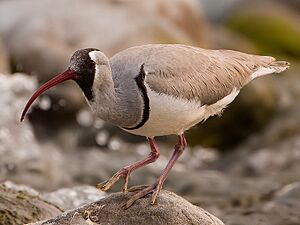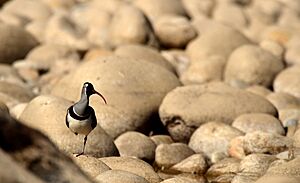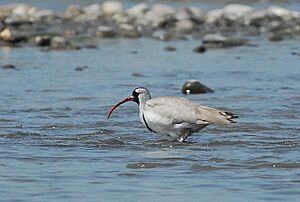Ibisbill facts for kids
Quick facts for kids Ibisbill |
|
|---|---|
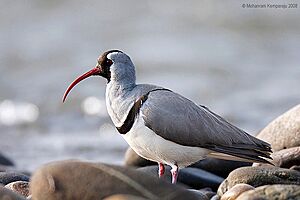 |
|
| Conservation status | |
| Scientific classification | |
| Genus: |
Ibidorhyncha
|
| Species: |
struthersii
|
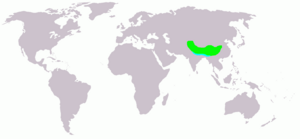 |
|
| Synonyms | |
|
Clorhynchus strophiatus Hodgson, 1835 |
|
The ibisbill (Ibidorhyncha struthersii) is a very special bird. It is related to waders, which are birds that walk in shallow water. But the ibisbill is so unique that it has its own family, called Ibidorhynchidae.
This bird is mostly grey with a white belly. It has bright red legs and a long, curved red beak. Its face and chest have a black band. You can find ibisbills on stony riverbanks. They live in the high plateaus of central Asia and the Himalayas.
Contents
About the Ibisbill
The ibisbill is part of a larger group of birds called Charadriiformes. This group also includes sandpipers, plovers, terns, and gulls. Scientists are still learning about its exact family tree. But it seems to be most closely related to oystercatchers and avocets. It is unique enough to have its own family, Ibidorhynchidae.
There are no different types or subspecies of the ibisbill. The bird was first described in 1831 by Nicholas Aylward Vigors. He based his description on a painting by John Gould. The species is named after Dr. Struthers, who collected some of these birds in the Himalayas.
What Does an Ibisbill Look Like?
The ibisbill is about 38 to 41 centimeters (15 to 16 inches) long. It's easy to spot because of its unique look. Adult ibisbills are grey with a white belly. They have a bright red, long, curved beak. This beak looks a bit like the beak of an ibis, even though they are not related.
They also have a black face and a black band across their chest. Male and female ibisbills look very similar. Young birds do not have the black on their face or chest. Their beaks are also not as bright.
The beak is about 6.8 to 8.2 centimeters (2.7 to 3.2 inches) long. Female ibisbills usually have slightly longer beaks. Their legs are a grayish-purple color in adult birds. Young birds or non-breeding adults have duller, greenish legs.
Ibisbills usually weigh between 270 and 320 grams (9.5 to 11.3 ounces). Females tend to be a little heavier than males. Even with their bright colors, they can be hard to see. They blend in well with their stony river homes.
The ibisbill has three toes. It does not have a back toe. Its outer and middle toes are slightly connected by a small web. The middle and inner toes are not connected.
Where Ibisbills Live
Ibisbills are common in Central Asia and the Himalayas. You can find them from Lake Issyk-Kul to the southern border of Manchuria. They also live in parts of Russia and Kazakhstan.
Ibisbills build their nests along stony riverbeds. They usually live at high altitudes, between 1,700 and 4,400 meters (5,600 and 14,400 feet). Sometimes, they can be found as low as 500 meters (1,600 feet).
When it's not breeding season, they might move to lower areas, sometimes as low as 100 meters (330 feet). They prefer wide river valleys with pebbles and small rocks. These areas often have sand and silt mixed in. The rivers they live near usually have slow-flowing water. This is important for them to find food.
Ibisbill Behavior
During autumn and winter, ibisbills are often alone. But you might see them in pairs or small groups of up to eight birds. One group of 25 ibisbills has even been seen!
When it's time to breed, they live alone and protect their territory. However, if there isn't much good habitat, they might nest closer to other ibisbills. They are usually not afraid of people. They are also good swimmers. They often swim across rivers instead of flying.
In winter, they are not very active. But as the breeding season gets closer, they become more active and noisy. Their call sounds like a ringing Klew-klew. It is similar to the call of a common greenshank. When they fly, their long neck and rounded wings make them look a bit like an ibis.
Reproduction and Nesting
Ibisbills seem to stay with one partner for breeding. During the breeding season, they might run short distances with their heads down. They only stand up straight to look around.
Their nest is a simple scrape on the ground. It is usually on a riverbank, island, or peninsula. Sometimes, they line the nest with small pebbles. Eggs are laid in late April or early May. The exact time depends on the weather.
A female ibisbill usually lays two to four oval eggs. Both parents share the job of sitting on the eggs to keep them warm. We don't know exactly how long it takes for the eggs to hatch. It is thought that chicks from the previous year might help their parents raise the new chicks.
What Ibisbills Eat
Ibisbills find their food by probing under rocks or gravel in stream beds. They eat many different kinds of small creatures. These include caddisfly and mayfly larvae, which hide under rocks in streams. They also eat grasshoppers and sometimes small fish.
Conservation Status
The ibisbill lives in a very large area. This area is estimated to be about 5 million square kilometers (1.9 million square miles). Scientists do not think their population is shrinking or that their habitat is breaking up.
We don't know the exact number of ibisbills. But their population is not thought to be declining. Because of these reasons, the IUCN lists the ibisbill as a species of Least Concern. This means they are not currently in danger of extinction.
Images for kids



